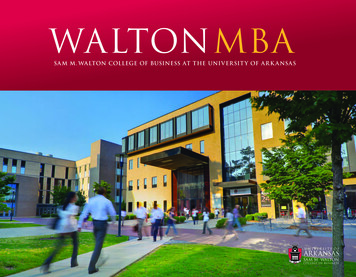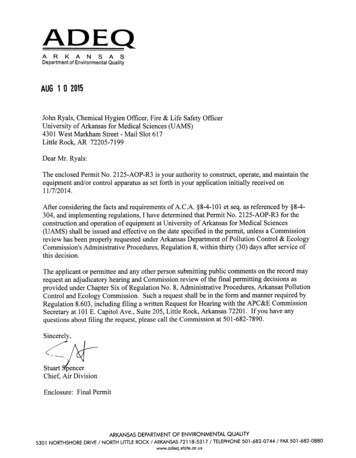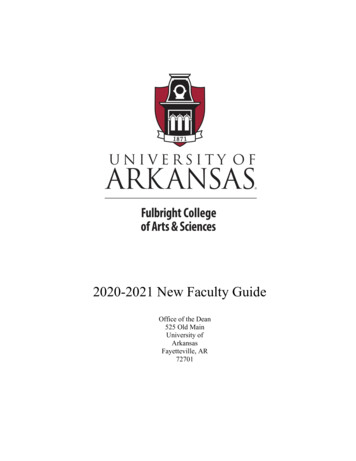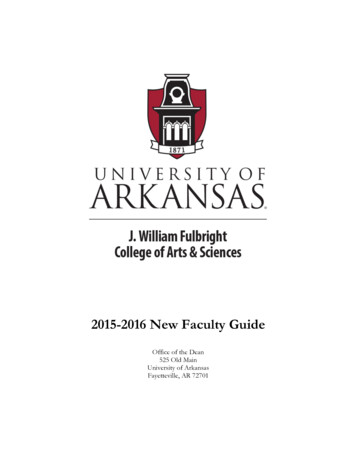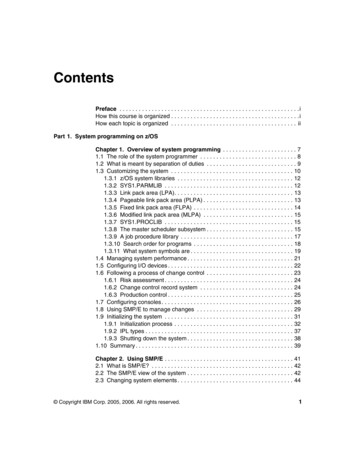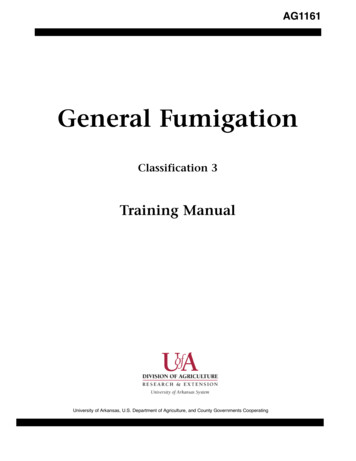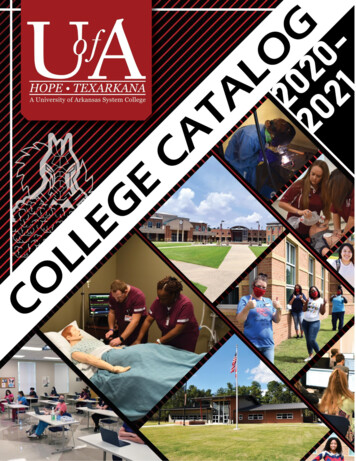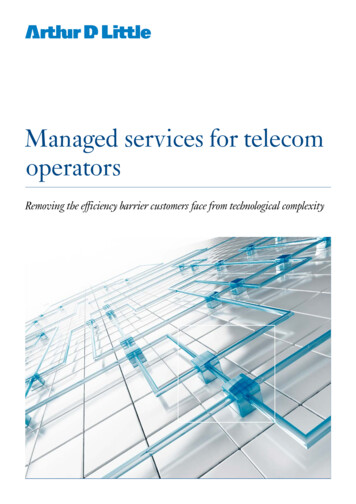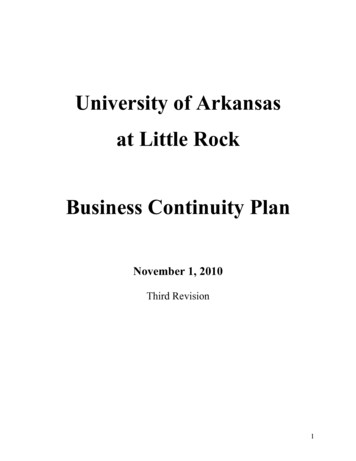
Transcription
University of Arkansasat Little RockBusiness Continuity PlanNovember 1, 2010Third Revision1
Table of ContentsSection 1: Plan Overview Introduction BCP Development Team Purpose Scope and Limitations Objectives Assumptions RecommendationsSection 2: Mission Critical Processes and Systems Business Impact Analysis MatrixSection 3: Threats and Risk Analysis Risk Assessment Matrix Disaster Risks and PreventionSection 4: Roles and Responsibilities Emergency Response Team Crisis Management Team Technical Recovery Management Team Data Recovery Management Roles and Responsibilities MatrixSection 5: Communications PlanSection 6: Contingency and Restoration Contingency Plans Restoration and Recovery Strategieso Technical Recoveryo Data Recoveryo Emergency Procurement ProceduresSection 7: Campus and Educational Awareness 2627AppendicesGlossary2
Section 1: Plan OverviewIntroductionThe Business Continuity Plan (BCP) for the University of Arkansas at Little Rock (UALR)integrates business risk management, operational risk management, and business continuity. Theplan recognizes a tiered approach to ensure the university is managed during a disaster thatrenders the technical infrastructure inoperable for a period exceeding two days. There are threeimportant steps in managing the university during and after a disaster occurs. The first step willbe implemented by activating the Campus Disaster Plan which ensures that health, life and safetyissues are addressed prior to the activationManualof this plan. The BCP includes a two-tiered approachContingencyto managing and restoring functionalityafter a disaster with three primary goals:CampusDisasterPlanPlanDataBusiness1. Facilitatefunctions of the universityContinuitycontinued performance of essential businessRecoverymanuallyPlan until the technical infrastructure can be restored.Strategies2. Activate the technical recoveryTechnicalplan that will be used to restore the technicalRecoveryinfrastructure to full functionality.3. Implement data recovery strategiesPlan to update the Banner system to ensure it remains up todate.This plan was developed by a cross-functional team to address the needs of the university in theevent of a crisis (2-5 days) or a disaster (over 5 days) that renders the campus network andcomputer systems infrastructure inoperable.Business Continuity Development TeamJudy Williams, CommunicationsMike Beaird, Law School LibraryLarry Dickerson, College of EducationCharles Ford, College of Information Services and Systems EngineeringJim Golden, College of Professional StudiesDennis Fleming, Computing ServicesSamuel Howell, Educational and Student ServicesLynette Jack, Ottenheimer LibraryJim Menth, College of Information Services and Systems EngineeringDiane Newton, FinanceCindy Milazzo, AdministrationJerry Stevenson, Provost3
Jeannie Winston, Vice Chancellor for Information Services, ChairStatement of PurposeThe primary focus of this document is to provide a plan to respond to a disaster that destroys orseverely cripples the University's technical infrastructure operated by the Computing ServicesDepartment. The intent is to restore operations as quickly as possible with the latest and most upto-date data available.Scope and LimitationsThe Business Continuity Plan will be executed after health, life and safety issues are addressed.Health, life and safety issues are addressed in the Campus Disaster Plan that is administered bythe Associate Vice Chancellor of Administration.Objectiveso The development and testing of a well-structured and coherent plan which will enableUALR to recover as quickly and effectively as possible from an unforeseen disaster oremergency which interrupts normal business operations by rendering the technicalinfrastructure inoperable for a period exceeding two days.o Establish cohesive emergency response and crisis management plan.o Develop a communications plan to notify teams, activate the plan, assemble personnel,assess damages, and declare a disaster.o Define mission critical processes using a Business Impact Analysis.o Define manual processes that can be implemented until the technical infrastructure isrestored.o Develop a plan to recover and restore the technical infrastructure to the UALR campus.o Establish criteria for making the decision to recover at a cold site or repair the affectedsite. Note: A cold site is an alternative location for computer and network equipment.o Describe an organizational structure for implementing the plan.o Provide information concerning the types of personnel who will be required to implementthe plan and define the skills and knowledge required.o Identify the equipment, floor plan, procedures, and other items necessary for the technicalrecovery.o Communicate the plan to the campus community.Assumptionso Health, life and safety issues are addressed by the Campus Disaster Plano The library collection is not in imminent danger of losso Restoration of utilities is addressed in the Campus Disaster Plano This plan covers catastrophic events. Planned and unplanned downtime of less than twodays are not addressed.o The Business Impact Analysis drives IT Restoration and Recovery Strategies.o Prevention is the most important aspect of continuity planning.o The Recovery Point Objective (RPO) defines the amount of data that can potentially belost in the event of a disaster. The RPO for the Banner system is one day or less.o The Recovery Time Objective (RTO) is the time frame in which the technicalinfrastructure is to be restored. The RTO is not quantified due to the lack of a redundantdata center and the unknown variables of how long it will take to prepare a cold site inthe event that Fribourgh Hall is damaged beyond use.4
o This plan will be reviewed and updated annually.Recommendations Conduct media relations training for senior management who may be required tointerface with the media during a disaster (on-going). Install a generator in FH and move air conditioning compressors to a more protectedlocation (feasibility study is 6,500) (complete). Move critical servers in FH to a location that is less susceptible to water leak from wetlabs in the floors above the data center (complete).5
Section 2: Mission Critical Processes and SystemsMission critical processes and systems are identified on the following Business Impact Analysismatrix. This matrix was developed by the BCP Team and is based on the impact to the campuscommunity. While the impact may vary depending on the timing of an event, the matrixassumes the university is in normal operating mode when the event occurs.Business Impact Analysis hPower/Utilities (1)XXNetworkXXBannerXX Payroll Registration Records Financial Aid Purchasing AccountsPayable AccountsReceivables Bookstore HealthServices Card AccessSystem AdmissionsE-mailXMediumLowXWeb ServerPhones (2)XXXImaging SystemXXX6
FunctionCrisis (2-5 Days)HighCommunicationsXResearch LabsXLibrary (3) (4)MediumDisaster (Over 5 Days)LowHighMediumLowXXXXTeaching on-linecourses (4)XTeaching webenhanced coursesXXXAssumptions:1. Utilities are a function of the campus disaster plan.2. Phones can be restored parallel to other activities.3. The library collection is intact with no danger of massive losses.4. Teaching on-line courses and the library are parallel activities that are performed bydifferent groups.7
Section 3: Threats and Risk AnalysisA threat is an event that causes a disruption in the normal university operating environment ofmore than two days. UALR recognizes two major types of threats: human andenvironmental/natural.Human threats include: Sabotage Terrorism Virus Bomb threats Robbery/thefts HackersEnvironmental and natural threats include: Tornado – physical damage Loss of power HVAC Flood Fire – FH or ADS high risk, others moderate Ice and/or snowstorm Lightning Wind damage EarthquakeBased on the above types of threats, the BCP team developed the following Risk AssessmentMatrix to identify what types of risks are high. The risks that are defined as high havecontingency plans developed to address prevention and controls to mitigate risks.Risk Assessment MatrixHuman RiskVirusHackers/CrackersLoss or absence ofkey personnel oncrisis teamsSabotageBomb ThreatTerrorismHighXXXEnvironmental RiskLoss of powerIce/snowFloodWater leak in criticalHighXXXXModerateLowXXXModerateLow8
areasFire (FH or ADS)HVACTornado (physicaldamage)LightningWind damageEarthquakeXXXXXXThe timeline for decision points for each risk will be evaluated individually to assess the actualrisk in the event of a disaster.Based on the Risk Assessment Matrix, UALR recognizes the following type of threats as highrisk for our campus. VirusHackers/CrackersLoss of technical personnelLoss of power to FHIce/SnowFloodWater leak in critical areas in FHDisaster Risks and PreventionIt is important to take reasonable measures to prevent a disaster or to mitigate the potential ofone. This portion of the plan reviews the various threats that can lead to a disaster, identifiesvulnerabilities, and steps that can taken to minimize our risk. The threats covered here are bothhuman and environmental/natural.Computer Crime (includes viruses and hackers/crackers)Computer crime is becoming more of a threat as systems become more complex and access ismore highly distributed. With the new networking technologies, more potential for improperaccess is present than ever before.Computer crime usually does not affect hardware in a destructive manner. It may be moreinsidious, and may often come from within. A disgruntled employee can build viruses or timebombs into applications and systems code. A well-intentioned employee can make coding errorsthat affect data integrity (not considered a crime, of course, unless the employee deliberatelysabotaged programs and data).9
Preventive MeasuresAll systems should have security products installed to protect against unauthorized entry. Allsystems should be protected by passwords, especially those permitting updates to data. All usersshould be required to change their passwords on a regular basis. All security systems should loginvalid attempts to access data, and security administrators should review these logs on a regularbasis.All systems should have the latest virus protection software. UALR has a site license forMcAfee and it is available at no charge to individual users.All systems should have the latest patches applied to operating systems. Computers without thelatest patches are more vulnerable to attack and can have a devastating impact on the campusnetwork.All systems should be backed up on a periodic basis. Those backups should be stored in an areaseparate from the original data. Physical security of the data storage area for backups must beimplemented. Standards should be established on the number of backup cycles to retain and thelength of their retention.RecommendationsContinue to improve security functions on all platforms. Strictly enforce policies and procedureswhen violations are detected. Regularly let users know the importance of keeping theirpasswords secret. Let users know how to choose strong passwords that are very difficult toguess.Improve network security. Shared wire media, such as thinnet ethernet, are susceptible tosniffing activities, which unscrupulous users may use to capture passwords. Implement strongersecurity mechanisms over the network, such as one-time passwords, data encryption, and nonshared wire media.Loss of technical personnelTechnical personnel have the capability of remotely accessing university systems. UALR hasthree data base administrators and several system administrators who have access to criticalsystems.Loss of power to the primary data center in Fribourgh HallA diesel generator has been installed that provides power to FH 213. The generator is testedmonthly to ensure that it is in working condition if and when it is needed to provide power to thedata center.Ice/SnowThe most likely result of an ice or snow storm is the loss of power associated with damage to thecommercial electric utility facilities that provide power to the UALR campus. The best methodof dealing with the potential damage of ice or snow is to follow the same course of action forloss of power and has been addressed with the installation of a generator in FH 213.10
Flood (includes water leak from wet lab on floors above the data center)The Fribourgh Hall Building is located on an area of elevation and is surrounded by lowerground. The Computing Services Data Center is on the second floor of Fribourgh Hall and is notlikely to flood from natural causes, however internal flooding from a broken pipe is a real threat.Not only could there be potential disruption of power caused by the water, a broken pipe cancause damage to cable or other sensitive electrical connections. Additionally, the presence ofwater in a room with high voltage electrical equipment can pose a threat of electrical shock topersonnel within the machine room.Preventive MeasuresMachines should not be located under pipes from the floor above. Care should be taken to moveexisting machines to areas of the machine room that are not under water pipes. Water detectorshave been installed and are operational. These detectors send messages to specified ComputingServices personnel.RecommendationsAn environmental monitoring system has been installed in FH 213 that will alert specifiedtechnical personnel if water is detected in the room.Additional threats to FH 213Additional threats to the technical infrastructure include fire, tornados and high winds,earthquake, and hazardous materials in FH. Even though these threats are not rated as high risk,each one is addressed individually due to the potential for extensive damage should one or moreoccur.FireFribourgh Hall is filled with electrical devices and connections that could overheat or short outand cause a fire. Additionally, there are batteries that produce hydrogen gasses in theUninterruptible Power Supply room where a spark could ignite a fire and explosion. A minimalrisk is that the computers within the facility also pose a quick target for arson from anyonewishing to disrupt University operations.Preventive MeasuresFire AlarmsThe Fribourgh Hall Building is equipped with a fire alarm system, with ceiling-mounted smokedetectors scattered widely throughout the building.Fire ExtinguishersHand-held fire extinguishers are required in visible locations throughout the building. Staff are tobe trained in the use of fire extinguishers.11
Building ConstructionThe Fribourgh Hall Building is built primarily of non-combustible materials. The risk to fire canbe reduced when new construction is done, or when office furnishings are purchased, to acquireflame resistant products.Training and DocumentationDetailed instructions for dealing with fire are present in Standard Operating Proceduresdocumentation. Staff are required to undergo training on proper actions to take in the event of afire. Staff are required to demonstrate proficiency in periodic, unscheduled fire drills.RecommendationsProcedures should be regularly reviewed to ensure that they are up to date.Regular inspections of the fire prevention equipment are also mandated. Fire extinguishers areperiodically inspected as a standard policy.A Halon fire suppression system should be installed in the data center. Equipment should bewired to be shut down with the press of a button located near the entrance/exit of the data center.Smoke detectors located under the machine room raised flooring should be periodicallyinspected and cleaned.Tornados and High WindsAlthough tornados and high winds are rated as low risk, the potential damage caused by atornado on the campus could severely damage or destroy Fribourgh Hall. In the event thatFribourgh Hall is destroyed, the likelihood of being able to rebuild the technical infrastructure ina timely manner is greatly diminished.Preventive MeasuresBuilding construction makes a big difference in the ability of a structure to withstand the forcesof high winds. Fortunately, Fribourgh Hall Building is a strong building. The exterior walls aresolid concrete. The data center has small movable windows; however the handles are removedto keep the windows closed. Strong winds are often accompanied by heavy rain, so a doublethreat of wind and water damage exists if the integrity of the roof is lost.RecommendationsAll occupants of Fribourgh Hall should know where the strong points of the building are and bedirected to seek shelter in threatening weather. The machine room operator is often unaware ofoutside weather conditions, so the machine room should be equipped with a weather alert radio.Computing Services should have large tarpaulins or plastic sheeting available in the machineroom area ready to cover sensitive electronic equipment in case the building is damaged.Protective covering should also be deployed over magnetic tape racks to prevent water and winddamage. Operators should be trained how to properly cover the equipment.The windows in the data center should be reinforced with metal for protection from flying debris.12
EarthquakeThe threat of an earthquake in the Little Rock area is low, but should not be ignored. Scientistshave predicted that a large earthquake along the New Madrid fault may happen any time in thenext 50 years, and that its effects will be felt as far away as our area. Buildings in our area arenot built to earthquake resistant standards like they are in quake-prone areas like California. Sowe could expect light to moderate damage from the predicted quake.An earthquake has the potential for being the most disruptive for this disaster recovery plan. Ifthe Fribourgh Hall Building is damaged, it is highly probable that the Cold Site on campus mayalso be similarly affected. Restoration of computing and networking facilities following a badearthquake could be very difficult and require an extended period of time due to the need forwide scale building repairs.Preventive MeasuresThe preventive measures for an earthquake can be similar to those of a tornado. Buildingconstruction makes all the difference in whether the facility will survive or not. Even if thebuilding survives, earthquakes can interrupt power and other utilities for an extended period oftime. Standby power generators could be purchased or leased to provide power whilecommercial utilities are restored.RecommendationsComputing Services should have large tarpaulins or plastic sheeting available in the machineroom area ready to cover sensitive electronic equipment in case the building is damaged.Protective covering should also be deployed over magnetic tape racks to prevent water and winddamage. Operators should be trained how to proper cover the equipment.Hazardous MaterialsThe risk of hazardous material was not rated nor discussed by the BCP. It is mentioned becauseof the presence of such items in Fribourgh Hall and the possibility of consequences if thebuilding is damaged by a tornado, high winds or an earthquake.There are hazardous materials present in the Fribourgh Hall Building. Four primary sources existfor these materials:1. Janitorial supplies - hazardous chemicals are present in the janitorial closets scatteredthroughout the building. The door to each closet contains a list of the chemicals present inthe closet. If this information is not present at the scene of the disaster, contact thePhysical Plant for a list of the chemicals located in the building.2. Battery acid - hazardous battery acid is present in large quantities in the UninterruptiblePower Supply room located in the extreme northwest corner of the first floor of thebuilding. Battery acid can cause caustic skin burns, blindness, and pulmonary distress ifinhaled.3. Hazardous Material Storage Area is just outside the entrance to the
3 Section 1: Plan Overview Introduction The Business Continuity Plan (BCP) for the University of Arkansas at Little Rock (UALR) integrates business risk manageme

